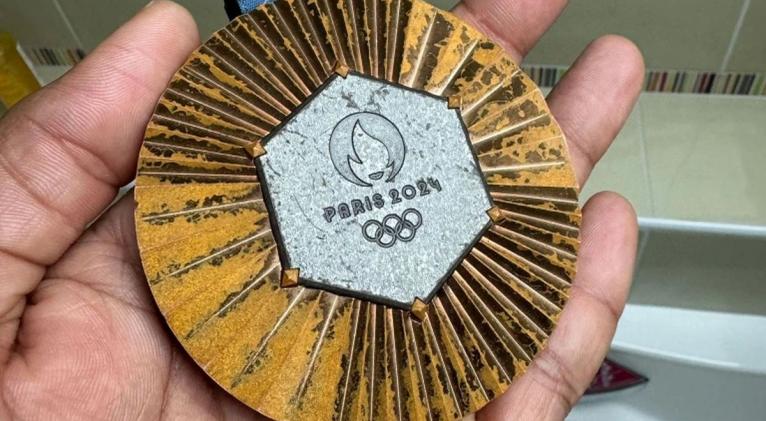From glory to disgrace: Paris 2024 medal scandal rocks IOC
especiales

The Paris 2024 Olympic Games promised to be a landmark event, but they have been plagued by controversy, even months after their conclusion. The medals distributed by the International Olympic Committee (IOC) are under fire for their poor quality, with many athletes joking that their condition resembles relics from the 1924 Paris Olympics—the last time the French capital hosted the Games.
Rust stains, surface wear, and a dull sheen that contrasts with the metal's original lustre have appeared after only a few months. Olympic medals are much more than just pieces of metal; they symbolise the highest sporting achievement. The production of these medals should involve the finest craftsmanship and the best materials, something the IOC seems to have overlooked. In France, this issue has almost become a matter of national pride. The progressive deterioration of the medals won at the Paris Olympics has shocked the French, a traditionally patriotic nation, who feel the fault in manufacturing the medals reflects poorly on their country.
The crisis has forced the IOC to issue a statement announcing that the faulty medals will be replaced. According to La Lettre, more than 100 athletes have contacted the IOC to return their medals for various reasons. The Organising Committee of the Paris Games is working closely with the Paris Mint to assess the complaints about the medals and understand the cause of their deterioration. "The defective medals will be systematically replaced and identically engraved by the Monnaie de Paris," the document stated. The replacement process will begin in the coming weeks, the IOC said.
A longstanding problem
The issue has been known since last summer. A few days or weeks after the Olympic Games, the first complaints came from athletes who had won medals in Paris. Their medals, mostly bronze, were already damaged—not just from poor care by their owners, who had worked hard for at least four years to earn them. Comments from Olympic athletes included "crocodile skin", "Paris 1924", and "after leaving them on my skin for a while with a little sweat and letting my friends handle them, they are not as high-quality as you would expect".
During the Games, British diver Yasmin Harper confirmed that the medals had begun deteriorating before the athletes had even left Paris. Harper, who was the first Briton on the podium at the Games, said her bronze medal had "tarnished a bit" and "faded". Similarly, American figure skater Nyjah Huston was one of the first to point out the poor quality of his medal on social media. In a video, Huston explained that his medal had begun to deteriorate after brief contact with skin and sweat, indicating a quality far below what is expected at an event like the Olympics, the pinnacle of sport.
Huston remarked on social media that while the medal "looked amazing when I put it on," after contact with skin and sweat, it quickly lost its lustre. "It looks like it's been to war," he said, showing the obvious wear and tear, particularly on the back where the Goddess of Victory is engraved. Even the front, where a small piece of the Eiffel Tower is embedded, was not immune to damage.
French swimmers Yohann Ndoye-Brouard and Clément Secchi shared pictures of the sorry state of their bronze medals, won in the 4×100m medley relay. The photographs showed the medals’ characteristic shine had vanished, leaving a dull, worn look unworthy of an Olympic souvenir. “Crocodile skin,” Secchi quipped. “Paris 1924,” his relay teammate Ndoye-Brouard added sarcastically.
Irish rowers Daire Lynch and Philip Doyle, who won bronze in the double sculls, returned their medals to the organisers for investigation into the severe damage. Lynch explained, “I wanted to keep mine, but they’ve taken it away to investigate. They want to see what’s wrong.” Doyle added, “Mine is smashed, almost destroyed.”
The medals feature an image of the Eiffel Tower on the back, with the event and athlete’s name inscribed at the base. Doyle noted that the top layer of his medal had deteriorated and shattered, with the underlying layers also showing signs of damage.
Manufacturing defects and accountability
Speaking to AFP, the Paris Mint dismissed the IOC's use of the term ‘defective’, opting instead to describe the medals as ‘damaged’, a response that highlighted the significant tension surrounding the issue. Chaumet designed a total of 5,084 gold, silver, and bronze medals for the Paris Games. Their production involved at least 30 stages and relied on the ‘savoir-faire’ of the Monnaie de Paris, one of France's oldest and most prestigious institutions
This public institution, founded in 1864 by Charles II, has produced Olympic medals for multiple Games, including the Athens 1896 and Paris 1924 editions. Months after athletes began denouncing the state of their medals, the crisis has escalated, leading to the resignation or dismissal of three senior officials responsible for production at the Paris Mint. According to La Lettre, those dismissed include the industrial director, Jacky Frehel, who stepped down in January; production director, Éric Matte, who has been absent since October; and the head of quality, Helène Juton, who left in December.
Winning an Olympic medal is a pinnacle achievement for most athletes, but for some Paris 2024 competitors, this hard-earned honour has been overshadowed by disappointment—though they have the option to receive replacements. Over the past four months, more than a hundred athletes have returned their medals to the Paris 2024 Organising Committee for the Olympic and Paralympic Games to have them repaired or replaced. This wave of returns, coupled with public complaints and widely shared images of damaged medals on social media, has culminated in a crisis that has triggered high-profile dismissals.
In addition to the issues with the Paris 2024 Olympic medals, the prestigious French institution faced another internal crisis a year ago, also related to its varnishing process. This time, the affected party was the Chinese multinational Huawei, a client of the Monnaie de Paris. The company distributes various medals made in Paris to its top employees. However, Huawei eventually returned a batch of more than 12,000 medals after employees noticed cracks, much to their disappointment.
"La Monnaie de Paris has taken the issue of damaged medals very seriously since the first exchange requests in August and has mobilised its internal teams," the mint said. Since then, the company has modified and optimised its varnishing process. La Monnaie de Paris will replace all damaged medals at the athletes' request during the first quarter of 2025, it assured.
The medals were designed by Parisian jewellers Chaumet, featuring a polished hexagonal piece of iron from the iconic Eiffel Tower embedded in each gold, silver, and bronze medal. Each medal measures 85 millimetres in diameter, is 9.2 millimetres thick, and weighs 529 grams for gold and 455 grams for bronze. The IOC explained that bronze medals are made from an alloy of copper, tin, and zinc, which makes them susceptible to moisture and sweat. Silver medals, on the other hand, are made of solid silver, while gold medals contain six grams of pure gold overlaid on sterling silver.
The medals sparked great interest among athletes due to their novel design, which incorporated a steel fragment from the Eiffel Tower, symbolising France's greatness. The latest developments in the crisis reveal the technical problem that caused the damage and deterioration of the medals over time. The issue stems from a last-minute regulatory change by the management of the Paris Mint, just before the medals were due to be produced.
A European directive banned the use of chromium trioxide, a toxic component previously used to make the varnish on the medals. The authorities had to replace it with a new varnish without sufficient time to test it. They are now working to find a solution for a new composition to maintain the medals in perfect condition and replace those returned by athletes, with the expectation that more medals will continue to be returned over time.
The composition of the medals appears to be the real problem. Bronze medals are typically made from an alloy of copper, zinc, and tin, which are less durable materials than those used for gold and silver medals. This potential flaw in the manufacturing standards has raised questions about whether the effort to include distinctive elements, such as a small fragment of the Eiffel Tower — the most powerful symbol of Paris and France — may have compromised the quality of the medals, as cheaper metals increase the rate at which bronze deteriorates.
For the Paris 2024 Olympics, it was emphasised that the medals would reflect a commitment to sustainability by being made from recycled materials, largely sourced from electronic equipment donated by citizens around the world. This initiative, which was praised at the time for its environmentally friendly approach, is now under scrutiny due to the spoilage incident.
The use of recycled materials in the production of Olympic medals was promoted as an innovation that aligned the Games with the values of sustainability and environmental responsibility. However, this case has raised concerns about whether the quality of these materials is comparable to those used in previous editions. The oxidation and premature wear observed on the bronze medals has led experts to question whether the recycling process may have compromised the integrity of the metal.
Some metallurgists have pointed out that while recycling is a valuable practice, it requires strict control over the composition of the materials to ensure the final products maintain the expected durability. In the case of Olympic medals, any defects in the metal composition could quickly manifest in adverse environmental conditions, such as exposure to moisture or chemicals, which could have negatively impacted the athletes' medals.
Crisis of reputation
The International Olympic Committee (IOC) is under increasing pressure to find a definitive solution, as athletes continue to share their experiences and joke about this bizarre Olympic episode on social media. News of the medal damage has sparked a wave of criticism and memes, negatively impacting public perception of the Paris 2024 Games.
Sponsors and brands associated with the Games have also voiced concern, as their reputations are linked to the quality of the event. Such a crisis could affect future sponsorship deals and public confidence in the Olympic brand. The efforts of an entire Olympic cycle, or even a lifetime, have been marred by the poor quality of the Paris 2024 medals.
Some athletes have seized the opportunity to discuss the importance of Olympic awards being of the highest quality, not just as symbols of achievement but as lasting mementoes. For many, the Olympic medal represents the pinnacle of a sporting career, and any flaw in its manufacture may be perceived as disrespectful to the effort and dedication of the athletes.
In an open letter dated 24 July, IBA President Umar Kremlev called for the immediate resignation of IOC President Thomas Bach, arguing that “medallists should receive awards made from the corresponding metals” and criticising the current medals as “disrespectful to the hard work and sacrifice of athletes.” Kremlev, a pioneer in introducing financial rewards for athletes, also questioned the IOC's business model, an idea later echoed by British tycoon Sebastian Coe, one of seven candidates competing to succeed Thomas Bach as IOC president.
The IOC has struggled to manage the Olympic controversy and the extensive media coverage it has generated, attempting to handle a significant reputational crisis. It achieved limited success when over 100 athletes worldwide reported that the medals they won at the Rio Olympics nine years ago began to deteriorate within months. According to the AFP news agency, the medals were "falling apart." Similar to Paris 2024, the IOC and organisers pledged to replace the damaged medals with new ones.
Kerri Walsh Jennings, a US beach volleyball star, mentioned that her bronze medal — like those from Paris — had rusted and broken. Rio 2016 spokesman Mario Andrada confirmed at the time that between six and seven percent of medals had problems. "The most common issue was that they were dropped or mishandled, causing the varnish to come off and leading to rusting or blackening where they were hit," he said.
The way forward
Olympic athletes from Paris 2024 have begun checking their medals for signs of deterioration. Many are hesitant to expose them, fearing further damage. Although no similar cases have been reported, the concern has prompted a closer examination of the medals awarded at the last Olympic Games.
While Paris 2024 organisers have promised to replace the faulty medals in response to the complaints, some athletes have yet to receive replacements. Kazakh boxer Nazym Kyzaibay, for instance, chose not to return her medal for replacement, despite expressing concerns about its quality upon returning from Paris.
“Both the IOC and France are responsible for the faulty medals. If this had happened in India, the whole world would be looking at us. These things should not be taken lightly," an Indian Olympic medallist told IANS, speaking on the condition of anonymity. "The Olympic medal is a lifetime achievement and a cherished memory, and if an athlete feels that their medal has deteriorated due to poor quality and needs replacing, we will approach the IOC for a replacement," said PT Usha, President of the Indian Olympic Association.
The premature deterioration of the Paris 2024 medals stands in stark contrast to the impeccable longevity of a gold medal awarded at the 1904 St Louis Olympics — the first Games held on US soil. The medal was auctioned as part of a collection of memorabilia spanning various Olympics over the decades.
Inscribed "Olympiad, 1904," the medal features an athlete holding a wreath of flowers on the obverse. On the reverse, Nike, the Greek goddess of victory, stands next to Zeus, the king of the gods, with the words marking the hurdles event for which the medal was awarded. This gold medal, presented to American Fred Schule, comes with its original ribbon and leather case.
These were the first Olympic Games to award gold medals, and the Americans dominated, winning 78 of the 96 events. Unlike today's Olympic medals, which are mostly gold-plated silver, the 1904 medals were smaller but entirely made of gold, ensuring their pristine condition. This is the envy of athletes who medalled at Paris 2024 and saw their success overshadowed by the oxidation of their medals. As Paris 2024 organisers continue to replace faulty medals, the scandal serves as a stark reminder that modernity must not come at the expense of quality — a lesson the IOC has learned too late.














Add new comment